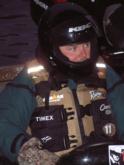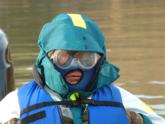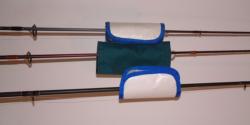Prepping for long runs

Fish FLW Outdoors events as a co-angler long enough and you will eventually draw a pro making a long run. Runs of 35 to 45 minutes are common on many lakes, but on bigger waterways, some anglers will run two hours one way to get to a hot spot.
I consider any run longer than an hour a long run. Long runs fall into two categories: calm runs and rough runs.
Calm runs
Long, calm runs are the easiest to deal with. These runs often take place on extensive river systems where rough water is not usually an issue.
A long run on smooth water means riding at high speeds for extended periods of time. The most tiring element in this case is wind resistance. The pro has a console, and unless it is a dual-console boat, the co-angler is like a wing catching wind.
This is especially true if you are donning heavy rain gear. Rain gear is great for blocking wind, but the problem is that it puts resistance on your body and your muscles compensate by pushing back.
A hood catches the wind and puts a prolonged strain on your head and neck areas. Muscles not used to this kind of intense use can fatigue easily.
The key is to change positions occasionally. Put your head down for few minutes to give your head and necks muscles a break.
Long high-speed runs in driving rain can be miserable. One trick I use is to sit down in the floor (not on the deck) and face backwards. The ride is more comfortable and you stay drier since you are not facing into the rain.
 Motorcycle helmets are certainly a consideration in these kinds of runs. They are aerodynamic, dry and quiet. The downside is they are cumbersome and take up a lot of room.
Motorcycle helmets are certainly a consideration in these kinds of runs. They are aerodynamic, dry and quiet. The downside is they are cumbersome and take up a lot of room.
Long, rough runs
Long, rough runs are runs of an hour or more through open water where high winds have whipped the surface up into 3- to 5-foot rollers.
The truth of the matter is that rough runs are no fun. Unfortunately, when you are subjected to an hour-long run in 3- to 5-foot seas, your comfort level has more to do with your pro’s rough water driving ability than anything else.
A skilled driver knows how to “surf” down the back of one wave, get the bow onto (not into) the next wave, motor up it. This kind of driving takes a great deal of patience and concentration.
If the pro is inexperienced, or worse yet, impatient, it is going to be more of a pummeling than a ride. An impatient driver jumps from wave to wave hoping that the boat is long enough to make it to the next wave.
The best advice I have for rough-water riding is to hang on and pay attention at all times. Riding in rough water takes almost as much concentration as driving in rough water.
I hang onto the side rail (left) and the strap (under seat on the right side on most boats) during every second of a rough-water ride. A boat’s momentum changes so suddenly and drastically that getting thrown out of the boat in these conditions is very possible.
You cannot just put your head down and ignore rough water. You have to pay attention to the boat’s attitude at all times. Seeing what the boat is doing allows you to “ride” the waves better and compensate for impact. I prefer to lean forward into the waves, just like the boat driver.
Consider storing rods and tackle
Because concentration needs to be at a premium, rough runs are easier to deal with if you do not have to worry about rods and tackle. Consequently, I make some special preparations for long runs.
First, I ask my pro if I can store my rods under the deck with his. This way you don’t have to constantly worry about your rods, which will inevitably come unbuttoned and bounce around.
Also, I will not use a tackle bag on long-run days. Before the day begins, I put all of my tackle in the back storage compartment behind the seat so there is nothing under my feet to distract me.
Stuffing waves is always a possibility in high seas, so I want everything stored. When you punch a wave, you don’t want to have to wonder where your rods or tackle have gone.
Judging conditions
Many times rough conditions catch anglers by surprise. They make a 30-minute run across a smooth lake in the morning and fish up in a protected creek all day. When they return to the main lake for the run back, the lake looks like the Gulf of Mexico in a hurricane.
When I first started fishing as a co-angler, I was ignorant of this phenomenon. Several times I drew pros that made a normal run to a remote creek or protected pocket and then pulled up the trolling motor at 1:00 P.M. and said, “We’ve got to start heading back.”
At first I was shocked. Two hours to get back when it only took 40 minutes to get there?
But when we got out to the main lake I quickly discovered why the pro was anxious to leave: 3-footers had blow out of a breeze that was hardly detectable in the creek (Sam Rayburn, Santee Cooper and Kentucky Lake come to mind). We needed every minute of those two hours to safely ride the waves back to weigh-in.
Deciding how much time is needed to get back based on how much the wind has picked up is the whole trick. The amount of time you have to get back is directly proportional to the beating you will take. If a pro is pushed for time, even the most skilled rough-water drivers are going to work you over.
The worst beatings I have taken as a co-angler had the same factors in common: not judging the conditions accurately and not having enough time to run the rough water going back.
If conditions get rough, don’t be bashful about recommending an early departure to your pro. Rides that took 40 minutes in the morning can easily turn into two-hour boat-driving contests on the way back. The whole key to handling rough water is having time on your side.
One of the best things I have found for co-angler use, for any kind of run, are Velcro-style lure wraps. Several companies make various versions, but essentially the wrap (made of tough, hook-resistant material) covers your lure and velcros together. They are fantastic for wrapping up jerkbaits and crankbaits to your rod so they don’t hook everything, including you.
Always carry an extra jacket for long runs, even in the summer. Don’t be fooled by summer’s warmth and hop into your pro’s boat with just shorts and sleeves on. If it’s 65 degrees in the morning, the wind chill at 70 mph can be nippy.
 Also, summer thundershowers can cool the air significantly. An 80-degree day can go to 60 degrees in an hour. Having an extra jacket to throw on for the hour-long run back is nice.
Also, summer thundershowers can cool the air significantly. An 80-degree day can go to 60 degrees in an hour. Having an extra jacket to throw on for the hour-long run back is nice.
Some excellent news for co-anglers is that 2003 Ranger Boats are now equipped with SRS (soft-ride seats) that have a spring compression system that absorbs shock. These seats make a tremendous difference in absorbing the impact when hitting waves. Once you ride in a boat equipped with SRS you will wonder why nobody invented them years ago.
Related links:
The Co-angler’s Clinic: Terminal tackle
The Co-angler’s Clinic: Co-angler etiquette
The Co-angler’s Clinic: Get the Net!
The Co-angler’s Clinic: Packing a manageable amount of tackle
The Co-angler’s Clinic: The importance of the pre-tournament meeting
The Co-angler’s Clinic: Arriving at the tournament site
The Co-angler’s Clinic: Packing for a fishing tournament means careful planning
The Co-angler’s Clinic: Analyzing the amateur experience
